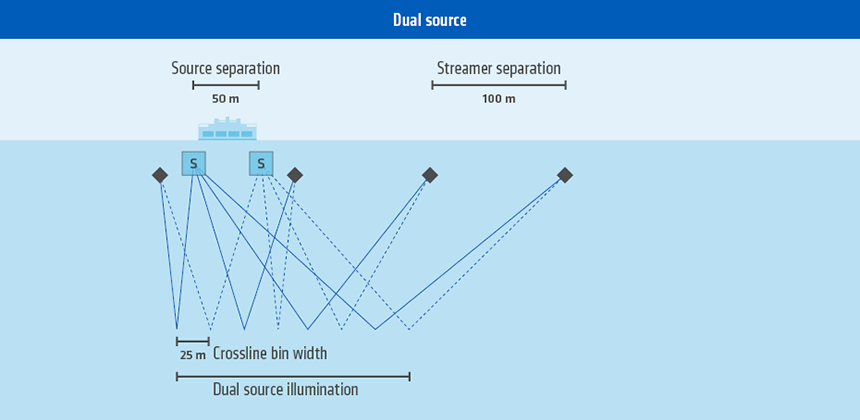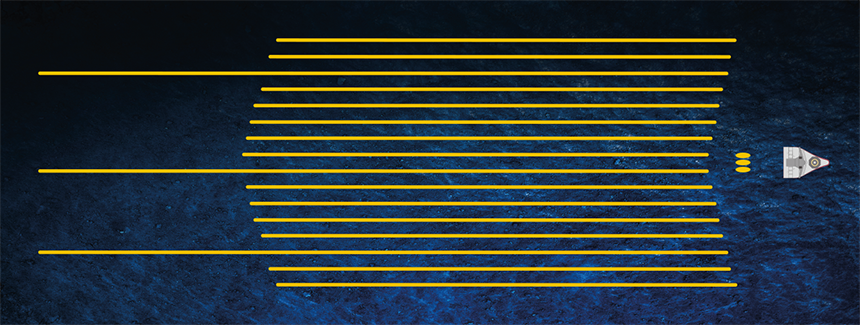Key Benefits
- Better data quality with denser cross-line spatial sampling and more uniform near offset distribution
- Improved efficiency without compromising cross-line sampling, either using fewer streamers or increasing overall width of the streamer spread
- Operational risk can be mitigated in areas with strong currents as towing fewer streamers reduces tangling risk
Track Record
The growing popularity of this source configuration suggests a gradual shift from dual to triple source. As PGS embarks on its 12th triple source acquisition since 2016, four of eight PGS seismic vessels are working on triple source projects in four countries and three continents: the UK, Norway, Indonesia and South Africa.
Of course, triple source comes with a tradeoff. To achieve the same in-line common mid-point (CMP) fold for triple compared to dual source acquisition, the shot interval must be decreased by 33%. This means a part of each shot record may include energy from the next shot.
PGS has gained extensive experience with simultaneous and overlap shooting since we first patented a variety of techniques to enable optimal simultaneous source acquisition and deblending in data processing.
The company's first commercial simultaneous source experience was gained on the industry's first simultaneous long offset (SLO) acquisition in 2012, followed by the large Triton full azimuth (FAZ) survey in the Gulf of Mexico in 2013 and 2014. The PGS GeoSource product is also based on blending and deblending techniques.


Source and streamer separation and fold comparison for dual vs triple source solution
Alternatives & Advantages
Let’s look a bit more closely at how recent PGS triple source projects leveraged the benefits offered by triple source:
- Efficiency: Triple source surveys in Malaysia and New Zealand maximized efficiency given the available tow width and streamer capacity. Ramform Sovereign operated with 14 x 112.5 meter and 12 x 150-meter spreads and PGS Apollo with 10 x 150 meter.
- Risk mitigation: Ramform Sovereign operated with a 10 x 150-meter spread offshore South Africa, due to strong rip currents in the survey area.
- Improved data quality: Recent surveys in the UK (Moray Firth) and Indonesia (West Timor) are designed to improve data quality, particularly resolution. We are using standard 12 x 75-meter streamer spreads with flip-flop-flap triple source shooting instead of standard dual source flip-flop patterns. The natural acquired crossline bin size is thus reduced to 12.5 meters.
UHD3D the Ultimate Configuration
Ramform Atlas is currently engaged in the Barents Sea towing the ultimate high-density solution. Exploration targets in large parts of the Barents Sea are relatively shallow and require broadband acquisition with proper spatial sampling to overcome imaging challenges.
The ultra-high towing capacity of the Ramform Titan-Class vessels enables PGS to acquire ultra-high-density 3D data. The 6000 sq. km Barents survey uses a streamer configuration of 16 x 56.25 meters. Combined with a triple source setup, this ultra HD3D survey will deliver a natural acquisition bin size of 6.25 x 9.375 meters. That is extraordinarily dense sampling for such a large seismic survey.
 The ultra-HD3D intelligent towing configuration is designed to address the specific imaging challenges of Barents Sea the modified front-end optimizes the near offset distribution, while the long tails record refractions and diving waves for improved velocity model building using FWI.
The ultra-HD3D intelligent towing configuration is designed to address the specific imaging challenges of Barents Sea the modified front-end optimizes the near offset distribution, while the long tails record refractions and diving waves for improved velocity model building using FWI.
The configuration illustrated above is tailored for areas with shallow targets and shallow water. It aims to record the full wavefield. This design is the outcome of geophysical planning and feasibility studies that draw on the experience PGS gained from the Barents Sea South-East MC3D programs in 2014 and 2015. That acquisition configuration was "only" 12 x 75 m (dual source), however in Imaging the signal was analyzed in the 2 – 200 Hz range at target level from the GeoStreamer data, which is clearly beyond aliasing conditions.
So denser natural sampling for new surveys in this and similar areas makes a lot of sense. We have also seen great uplifts from full waveform inversion (FWI) driven velocity model building in the Barents Sea. That led to another smart adjustment to the 2018 intelligent towing configuration. While the streamer length for the UHD3D design is 7 km for the majority of the streamer spread, three of the 16 cables are 10 km long. These make it possible to record deeper refractions, improving resolution and the accuracy of velocity models.
Typically Titan-class
In conclusion, combining an HD3D configuration with triple source can offer both efficiency and data quality benefits. With the flexibility to think beyond the limitations of a standard seismic vessel, they can be tailored to fit the operational and geological situation.
Currently, only four seismic vessels are able to deliver this novel 16 x 56.25 m x 7 000 m/10 000 m streamer configuration: The four Titan-Class Ramform vessels in the PGS fleet.
Contact a PGS expert
If you have a question related to our Marine Acquisition services or would like to request a quotation, please get in touch.